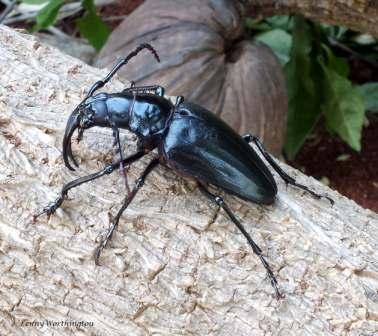| Author |
 Topic Topic  |
|
|
Lenny
Member Purpuricenus
 
Thailand
361 Posts |
 Posted - 24/06/2017 : 07:25:05 Posted - 24/06/2017 : 07:25:05



|
 
60 mm
Punjen Phrae
June 2017 |
Lenny |
|
|
Xavier
Scientific Collaborator
    
France
12215 Posts |
 Posted - 24/06/2017 : 13:24:08 Posted - 24/06/2017 : 13:24:08



|
| The full name is Dorysthenes (Baladeva) walkeri Waterhouse, 1840. |
 |
|
|
Jaguarito
Member Purpuricenus
 
France
145 Posts |
 Posted - 24/06/2017 : 15:05:17 Posted - 24/06/2017 : 15:05:17



|
| The range of my collection is from 42 mm to 80 mm. The small one looks as it would be another species, compared to the other ones. The impression that enormous difference gives is incredible, but of course there is no possible mistake, it is just a dwarf. |
 |
|
|
Capitaine
Scientific Collaborator
   
France
1841 Posts |
 Posted - 27/06/2017 : 15:55:24 Posted - 27/06/2017 : 15:55:24



|
I don't understand why a size of 60mm (6cm) for this species seems to be incredible !
In any case this guy is the widespread D. walkeri. |
Claude |
 |
|
|
Jaguarito
Member Purpuricenus
 
France
145 Posts |
 Posted - 27/06/2017 : 17:28:28 Posted - 27/06/2017 : 17:28:28



|
Enormous misunderstanding. As my range is from 42 to 80, I have of course many specimens around 60 mm.
What is incredible is to see a giant one (80 mm) and a dwarf (42 mm) one close to the other. If it was not for the unmistakable mandibles, you would swear it cannot be the same species ! Due to the three dimensions, it means that the big one has around 7 times the volume of the small one. |
Edited by - Jaguarito on 27/06/2017 17:33:45 |
 |
|
|
Capitaine
Scientific Collaborator
   
France
1841 Posts |
 Posted - 28/06/2017 : 17:46:48 Posted - 28/06/2017 : 17:46:48



|
Ok, I understand better. In fact, due to the environmental conditions during the larval stage, from time to time you can find a specimen having an outstanding size (giant or dwarft), but it's just a specimen which benefited from optimal or bad conditions in the larval stade.
I have many exemples of such size discrepancies among Prionini and Macrotomini (ex: D. granulosus 70mm and 40mm).. |
Claude |
 |
|
| |
 Topic Topic  |
|


